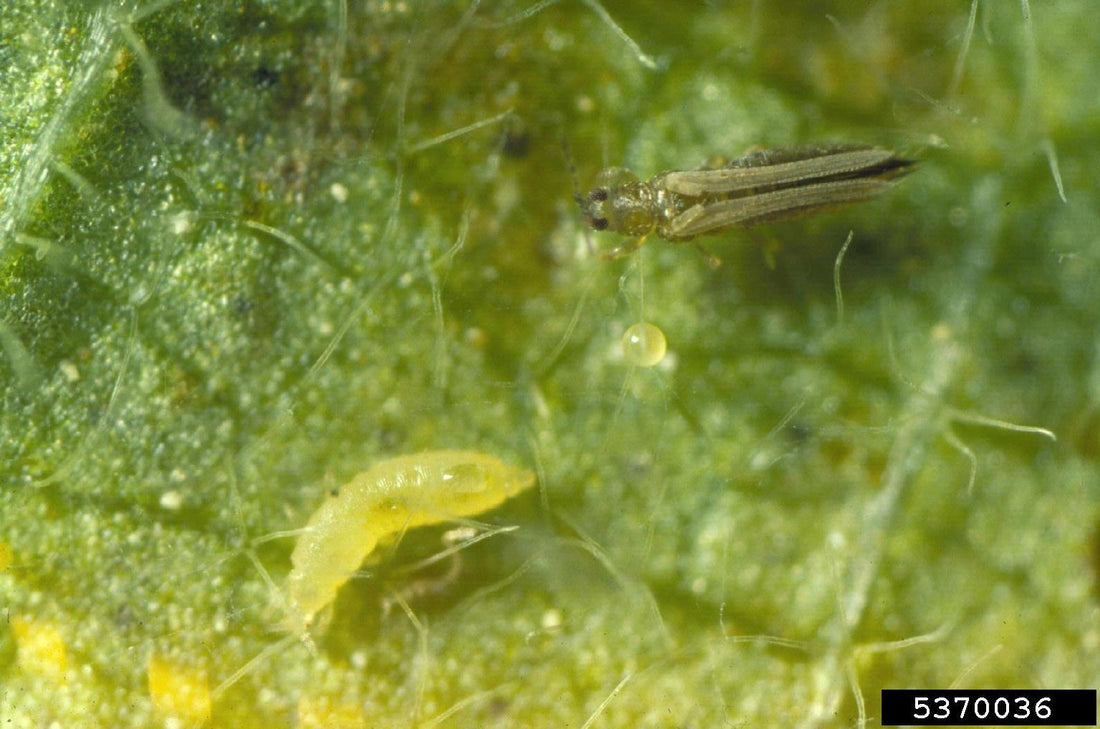Thrips are some of the tiniest pests you’ll run into in the garden—barely 1 millimeter long and almost invisible without magnification. Most of the time, you’ll notice the damage they leave behind before you ever spot the insects themselves.
These pests attack a wide range of plants, from roses and tomatoes to onions and garlic. Some thrips specialize in certain plants, while others feed on just about anything they can find. They’re especially troublesome indoors or in greenhouses, where populations can explode. To make matters worse, thrips can spread plant viruses like tomato spotted wilt virus, which has no cure. If a plant shows signs of this disease, remove it right away to keep it from spreading.
How to Identify Thrips
 Photo: Jack T. Reed, Mississippi State University, Bugwood.org
Photo: Jack T. Reed, Mississippi State University, Bugwood.org
 Photo: Shimat Joseph, University of Georgia
Photo: Shimat Joseph, University of Georgia
Adult thrips are slender, yellow to light brown insects with fringed wings, though they can also be gray, black, or patterned. They tend to scurry or hop around more than fly, but can swarm in large numbers. Immature thrips are even smaller and usually yellowish.
The damage they cause is easier to spot than the insects themselves. Thrips have rasping, sucking mouthparts that scrape plant tissue and suck out the contents. This leaves behind silvery or white patches, distorted leaves, or flowers with faded colors and brown petal edges. Another telltale sign is the dark green to black specks of droppings left behind where they feed.
If you suspect thrips, try holding a sheet of white paper under a plant and tapping the leaves or flowers—tiny thrips will fall onto the paper, making them easier to see.
Understanding Thrips
Thrips aren’t strong fliers; most spread by wind. Females lay eggs inside plant tissue, and when they hatch, the young immediately begin feeding. Most of the damage comes from these immature stages. Once ready, they drop into the soil to pupate, then emerge as adults to repeat the cycle. Multiple generations can occur in a single season, making them tough to manage if you don’t catch them early.
How to Get Rid of Thrips
While thrips can be stubborn, consistent management can keep them under control.
-
Inspect plants regularly. Catching infestations early makes control much easier.
-
Use yellow sticky traps. These won’t eliminate thrips but will help you monitor populations.
-
Encourage beneficial insects. Lacewings, pirate bugs, and other “good bugs” naturally feed on thrips. Planting nectar-rich flowers helps attract them.
-
Wash plants off. Spray both sides of leaves with a strong stream of water to knock thrips off, or wipe with a damp cloth for smaller infestations.
-
Use natural sprays. Insecticidal soaps and neem oil are good first steps. Apply thoroughly and repeat as needed, since these treatments only work on direct contact.
-
Consider chemical controls if infestations are severe. Products with Spinosad (like Ferti-Lome Green Spinosad) can be very effective, but they also impact beneficial insects. Use carefully and only when necessary.
- Ferti-Lome Green Spinosad Concentrate – mix 2 oz per gallon of water and spray all plant parts, including leaf undersides. This is an organic option effective against thrips.
- Remove infected plants. If thrips have spread tomato spotted wilt virus, there’s no saving the plant. Discard it immediately (do not compost).
- For houseplants, isolate and treat. Keep infected plants separate and treat with insecticidal soap or horticultural oil.
-
Pre-treat for Prevention:
- Ferti-Lome Systemic Spider Mite Spray – controls thrips with a systemic action. Mix 1–2 tablespoons per gallon of water and apply as a mist.
-
Hi-Yield Systemic Insect Spray – mix 1½ teaspoons per gallon of water and apply as a foliar spray when thrips first appear. Repeat every 10–14 days as needed. Always follow label directions for safe use.
The bottom line: thrips are small but mighty pests that can quickly get out of hand if left unchecked. With regular inspection, natural controls, and timely treatments, you can keep your garden thriving and your plants healthy.

